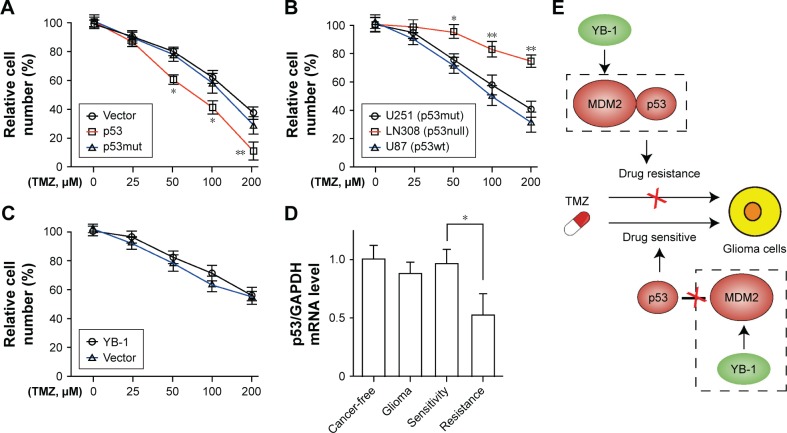Figure 4.
YB-1 modulates p53-mediated TMZ resistance in glioma cells.
Notes: (A) Cell viability were analyzed in wild-type U87, p53-overexpressed U87, and p53 mutant-overexpressed U87 after treatment with 0–200 µM TMZ for 48 hours. *P<0.05, **P<0.01 vs the control group. (B) Cell viability was analyzed in U87 (p53wt), U251 (p53mut), and LN308 (p53null) cells after treatment with 0–200 µM TMZ for 48 hours. *P<0.05, **P<0.01 vs the control group. (C) Cell viabilities were analyzed in LN308 cells and YB-1-overexpressed LN308 cells after treatment with 0–200 µM TMZ for 48 hours. (D) qRT-PCR analysis showed the expressions of p53 in glioma tissues and cancer-free tissues. *P<0.05 vs the control group. (E) The schematic diagram presented that YB-1 facilitates glioma cells resistance to temozolomide by activation of MDM2/p53 pathway. The increased level of YB-1 led to activation of MDM2 and results in p53 degradation. Deficiency of p53 cannot trigger p53-dependent DNA damage repair process and results in the uncontrolled growth of tumor cell and a resistance to chemoradiotherapy. Conversely, disability or inhibition of YB-1 or MDM2 leads to an accumulation of p53 and activation of p53-mediated DNA damage repair process, which leads to a p53-dependent drug-sensitive response.
Abbreviation: TMZ, temozolomide.

